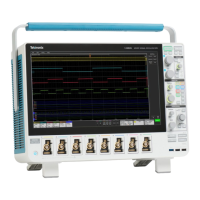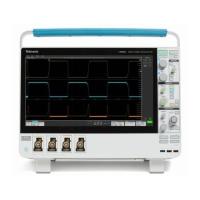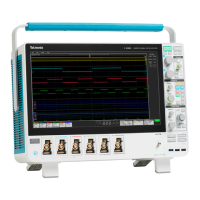Time controls Gate controls Frequency controls Magnitude controls Phase controls
Source Position Center dB, dBm linear, real
imaginary
degrees, radians, group
delay
Duration, record length Duration Span Ref level Zero threshold
Duration, sample rate Window Resolution bandwidth Ref level offset Phase Unwrap
Resolution
What do you want to do next?
Learn about using spectral analyzer windows.
Learn how to recognize aliasing.
Go to a step-by-step procedure for defining a spectral math waveform.
Spectral math time controls
The operation of the time domain controls for the spectral analyzer is summarized by the following rules:
■
Duration selects the time from the beginning to the end of the acquired waveform. You may set duration using the record
length control or the sample rate control.
■
Resolution determines the time between samples. Duration is kept constant as resolution is changed. Therefore, the
Resolution control affects both the sample rate and the record length simultaneously.
■
Most often, you will want to use a short record length because long record lengths can slow instrument response. However,
long record lengths lower the noise relative to the signal and increase the frequency resolution for the spectral math
waveform. More importantly, they might be needed to capture the waveform feature that you want to include in the
waveform.
Examples of how duration and resolution affect the acquired waveform are shown in the next figure.
Oscilloscope reference
DPO70000SX, MSO/DPO70000DX, MSO/DPO70000C, DPO7000C, and MSO/DPO5000B Series 717

